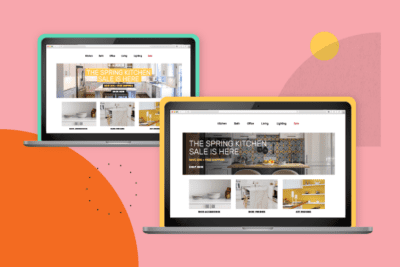
Getting Started with Homepage Personalization Techniques
Some retail brand leaders (particularly towards the more luxury end of the spectrum) have traditionally viewed their site homepages as highly curated canvases—much like the front window display of a store. I’m an artist myself, so I’m very sympathetic to the concept of a unified brand aesthetic. However, these brands are limiting their ability to convert more customers and increase revenue by not utilizing homepage personalization.

The Benefits of Homepage Personalization
Personalization really is the key to unlocking the most revenue from your homepage. I know that every marketer (and technology partner) seems to have a different definition for it…and that’s a topic for a future blog post. It can mean dynamically updating a homepage banner based on previous purchases, or serving a recommendation slider with products relevant to a specific visitor. For marketers still building the case for personalized homepages, let’s focus on 1-to-1, AI-driven personalization and how retailers are using Monetate’s personalization platform to increase revenue.
To illustrate why, let’s look at a real-world example of homepage personalization where I’ve only removed identifying features about the brand. A current Monetate customer and well-known retail and eCommerce brand (with a top-down culture of viewing the homepage as a work of art) decided to launch a pilot to compare personalized performance with the one-size-fits-all approach.
With executive buy-in achieved and a goal metric (click-through) set, the next step was establishing how to personalize the homepage. Should they create variants specific for genders or product lines or something else? We ultimately decided to create variants across four of these, including the traditional curated homepage as a “control,” and let the Monetate Personalization Engine decide what visitors would see.
Key results? After 14 days, the Individual Fit Experience drove a cumulative +26.42% lift in click-through from the homepage. Using Monetate, the marketing team was also able to get insight into which categories our AI-powered engine determined were most influential to assign traffic to our goal metric, and this will help them plan future strategies.
How to Start With Homepage Personalization
As you can see, executing a homepage personalization strategy and running a successful pilot test can be done with minimal variants and the data you already have. If you’re ready to get started, here are some additional tips from my work with leading retailers:
- Start small. Most homepages already include a wide range of persona-specific products. Using an Individual Fit Experience to update what content is above the fold can be incredibly effective, and it doesn’t require any additional resources.
- Trust the personalization engine. This isn’t the typical “If you bought this, show this” type of experience, and we have proven results. With a clear goal, you just need to let the engine learn and make the right decisions. Remember that you’re still in control of all the variants.
- Bring data. Monetate’s Individual Fit Experiences can make decisions out-of-the-box based on context it can “see” but your first-party data can also ensure visitors are getting the perfect experience.
Why Personalized Homepages Work + A Case Study
- Monetate customers use what we call “Individual Fit Experiences,” a form of dynamic testing, to deliver personalized homepages to their site visitors. This method uses both first- and third-party data to inform individualized content decisions—meaning that each site visitor receives a unique combination of the variants determined to be most likely relevant to them.
- This is different from something like an A/B test, where it’s certain that a random section of your target will see a less relevant experience. In fact, Monetate examined data from over 2 billion personalized experiences in order to learn how manual methods perform compared with their AI counterparts. Our finding? Individual Fit Experiences succeed 4X as often as A/B tests.